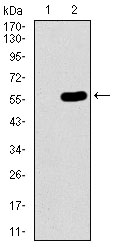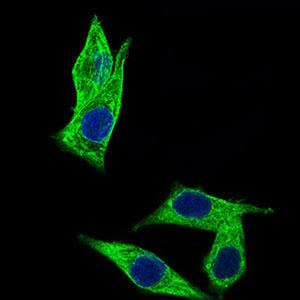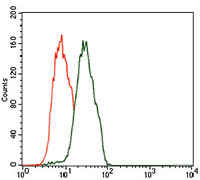Product Detail
Product NameC17ORF53 Antibody
Clone No.A9-A3
Host SpeciesMouse
ClonalityMonoclonal
PurificationProA affinity purified
ApplicationsWB, ICC, FC
Species ReactivityHu
Immunogen DescRecombinant protein
ConjugateUnconjugated
Other NamesC17orf53 antibody
Chromosome 17 open reading frame 53 antibody
CQ053_HUMAN antibody
FLJ11594 antibody
Hypothetical protein LOC78995 antibody
MGC3130 antibody
Uncharacterized protein C17orf53 antibody
Accession NoSwiss-Prot#:Q8N3J3
Uniprot
Q8N3J3
Gene ID
78995;
Formulation1*TBS (pH7.4), 1%BSA, Preservative: 0.05% Sodium Azide.
StorageStore at -20˚C
Application Details
WB: 1:500-1:1,000
ICC: 1:50-1:200
FC: 1:100-1:200
Western blot analysis of C17ORF53 on human C17ORF53 recombinant protein using anti-C17ORF53 antibody at 1/1,000 dilution.
Western blot analysis of C17ORF53 on HEK293 (1) and C17ORF53-hIgGFc transfected HEK293 (2) cell lysate using anti-C17ORF53 antibody at 1/1,000 dilution.
ICC staining C17ORF53 (green) in HepG2 cells. The nuclear counter stain is DAPI (blue). Cells were fixed in paraformaldehyde, permeabilised with 0.25% Triton X100/PBS.
Flow cytometric analysis of Jurkat cells with C17ORF53 antibody at 1/100 dilution (green) compared with an unlabelled control (cells without incubation with primary antibody; red).
C17orf53 (chromosome 17 open reading frame 53) is a 647 amino acid protein that is encoded by a gene mapping to human chromosome 17. Chromosome 17 makes up over 2.5% of the human genome with about 81 million bases encoding over 1,200 genes. Two key tumor suppressor genes are associated with chromosome 17, namely, p53 and BRCA1. Tumor suppressor p53 is necessary for maintenance of cellular genetic integrity by moderating cell fate through DNA repair versus cell death. Malfunction or loss of p53 expression is associated with malignant cell growth and Li-Fraumeni syndrome. Like p53, BRCA1 is directly involved in DNA repair, specifically it is recognized as a genetic determinant of early onset breast cancer and predisposition to cancers of the ovary, colon, prostate gland and fallopian tubes. Chromosome 17 is also linked to neurofibromatosis, a condition characterized by neural and epidermal lesions, and dysregulated Schwann cell growth. Alexander disease, Birt-Hogg-Dube syndrome and Canavan disease are also associated with chromosome 17.
If you have published an article using product 48447, please notify us so that we can cite your literature.






 Yes
Yes



